
Mecklenburg-Vorpommern ; also known by its anglicized name Mecklenburg–Western Pomerania, is a state in the north-east of Germany. Of the country's sixteen states, Mecklenburg-Vorpommern ranks 14th in population; it covers an area of 23,213 km2 (8,963 sq mi), making it the sixth largest German state in area; and it is 16th in population density. Schwerin is the state capital and Rostock is the largest city. Other major cities include Neubrandenburg, Stralsund, Greifswald, Wismar, and Güstrow. It was named after the two regions of Mecklenburg and Vorpommern, and its name means the "nearer part of Pomerania", with the rest now lying in Poland.
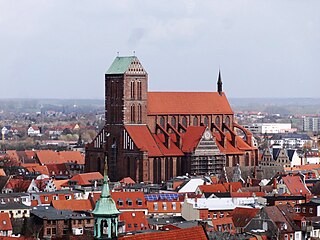
Wismar, officially the Hanseatic City of Wismar is, with around 43,000 inhabitants, the sixth-largest city of the northeastern German state of Mecklenburg-Vorpommern, and the fourth-largest city of Mecklenburg after Rostock, Schwerin and Neubrandenburg. The city was the third-largest port city in former East Germany after Rostock and Stralsund.

Rostock officially the Hanseatic and University City of Rostock, is the largest city in the German state of Mecklenburg-Vorpommern and lies in the Mecklenburgian part of the state, close to the border with Pomerania. With around 210,000 inhabitants, it is the third-largest city on the German Baltic coast after Kiel and Lübeck, the eighth-largest city in the area of former East Germany, as well as the 39th-largest city of Germany. Rostock was the largest coastal and most important port city in East Germany. The city has a large population of herring gulls that squawk loudly most days throughout the year.

Stralsund (German pronunciation:[ˈʃtʁaːlzʊnt] ;, officially the Hanseatic City of Stralsund, is the fifth-largest city in the northeastern German federal state of Mecklenburg-Western Pomerania after Rostock, Schwerin, Neubrandenburg and Greifswald, and the second-largest city in the Pomeranian part of the state. It is located on the southern coast of the Strelasund, a sound of the Baltic Sea separating the island of Rügen from the Pomeranian mainland.

The Prague astronomical clock or Prague Orloj is a medieval astronomical clock attached to the Old Town Hall in Prague, the capital of the Czech Republic.
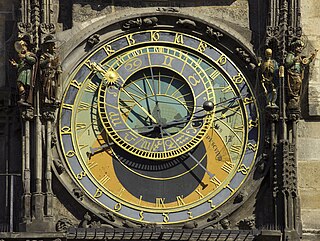
An astronomical clock, horologium, or orloj is a clock with special mechanisms and dials to display astronomical information, such as the relative positions of the Sun, Moon, zodiacal constellations, and sometimes major planets.

The Zytglogge is a landmark medieval tower in Bern, Switzerland. Built in the early 13th century, it has served the city as a guard tower, prison, clock tower, centre of urban life and civic memorial.

A striking clock is a clock that sounds the hours audibly on a bell, gong, or other audible device. In 12-hour striking, used most commonly in striking clocks today, the clock strikes once at 1:00 am, twice at 2:00 am, continuing in this way up to twelve times at 12:00 mid-day, then starts again, striking once at 1:00 pm, twice at 2:00 pm, up to twelve times at 12:00 midnight.
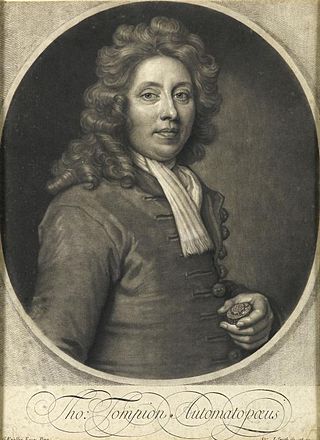
Thomas Tompion, FRS (1639–1713) was an English clockmaker, watchmaker and mechanician who is still regarded to this day as the "Father of English Clockmaking". Tompion's work includes some of the most historic and important clocks and watches in the world, and can command very high prices whenever outstanding examples appear at auction. A plaque commemorates the house he shared on Fleet Street in London with his equally famous pupil and successor George Graham.
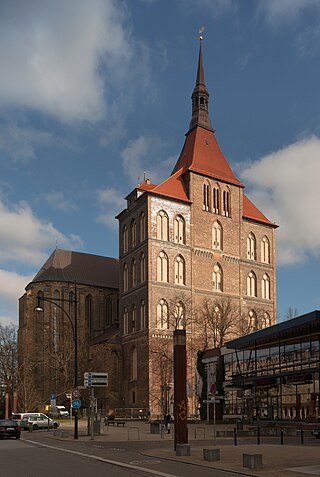
St. Mary's Church, Rostock, in German Marienkirche, is the biggest of three town churches found in the Hanseatic city of Rostock, in northern Germany. The other two are St. Peter's (Petrikirche) and St. Nicholas (Nikolaikirche). A fourth, St. James' (Jakobikirche), was heavily damaged during the Second World War and subsequently demolished. St. Mary's was designated in 1265 as the main parish church. Since the Protestant Reformation in 1531, it houses a congregation of the Evangelical Lutheran State Church of Mecklenburg.
Hans Düringer was a clockmaker from Nuremberg in Germany who died 1477 in Rostock. His most famous works are
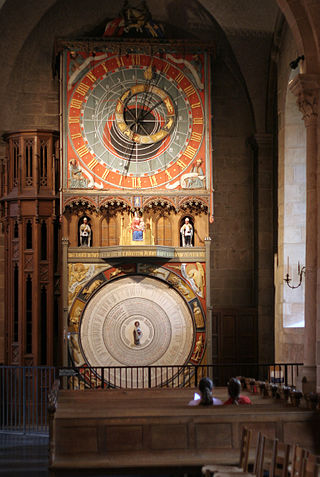
Lund astronomical clock, occasionally and at least since the 16th century referred to as Horologium mirabile Lundense, is a 15th-century astronomical clock in Lund Cathedral. Mentioned in written sources for the first time in 1442, it was probably made and installed sometime around 1423–1425, possibly by Nikolaus Lilienfeld. It is part of a group of related medieval astronomical clocks found in the area around the south Baltic Sea. In 1837 the clock was dismantled. Between 1909 and 1923, it was restored by the Danish clockmaker Julius Bertram-Larsen and the Swedish architect responsible for the upkeep of the cathedral, Theodor Wåhlin. From the old clock, the face of the clock as well as the mechanism, which was largely replaced during the 18th century, was salvaged and re-used. The casing, most parts of the calendar which occupies the lower part, and the middle section were made anew.

The Rostock astronomical clock is a fifteenth-century astronomical clock in St. Mary's Church, Rostock.

Ottery St Mary Astronomical Clock is a 14th-century astronomical clock in St Mary's Church, Ottery St Mary, in Devon in south-west England.
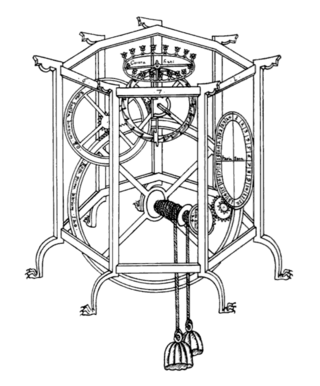
The Astrarium of Giovanni Dondi dell'Orologio was a complex astronomical clock built between 1348 and 1364 in Padova, Italy, by the doctor and clock-maker Giovanni Dondi dell'Orologio. The Astrarium had seven faces and 107 moving parts; it showed the positions of the sun, the moon and the five planets then known, as well as religious feast days. It was one of the first mechanical clocks to be built in Europe.

St. Nicholas Church is the oldest of the three major parish churches of the Hanseatic city of Stralsund in Germany. It was dedicated in 1279 to St. Nicholas of Myra, the patron saint of sailors. Since 1524 it has been an Evangelical Lutheran church. It is one of the earliest examples of the introduction of the cathedral pattern of northern France into the Brick Gothic architecture of the Baltic region. As part of the historic centre of Stralsund, St. Nicholas Church was inscribed on the UNESCO World Heritage List in 2002.
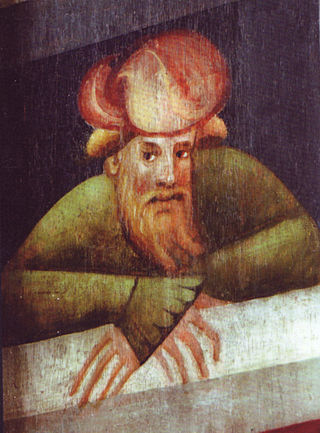
Nikolaus Lilienfeld was a German engineer and clockmaker of the late 14th and early 15th centuries.
Manfred Schukowski is a German academic teacher and author of works on astronomical clocks.

The Münster astronomical clock is an astronomical clock in Münster Cathedral in Münster, Germany.




















